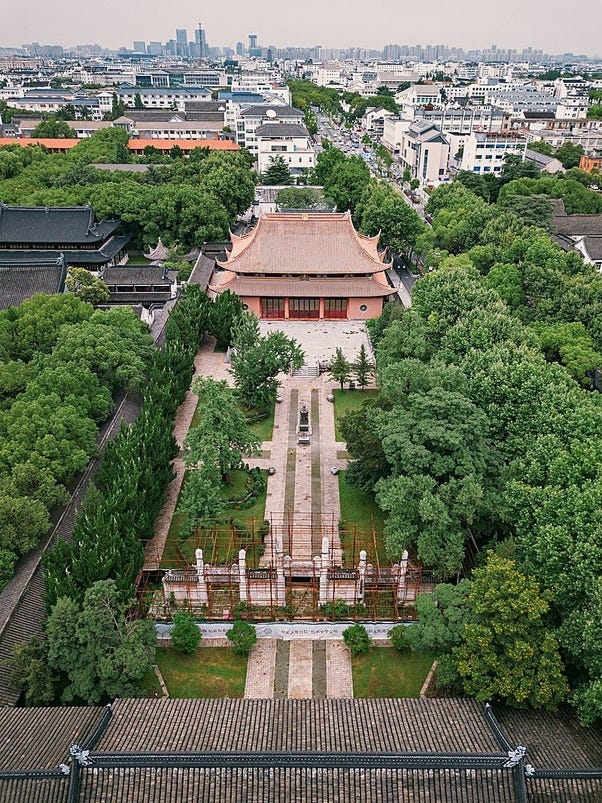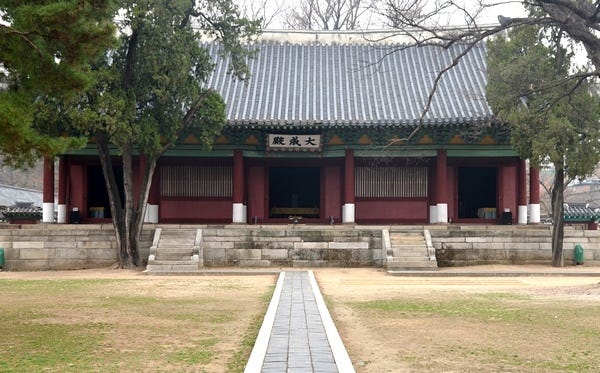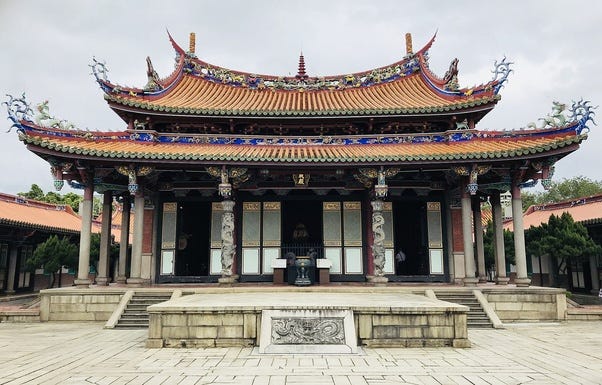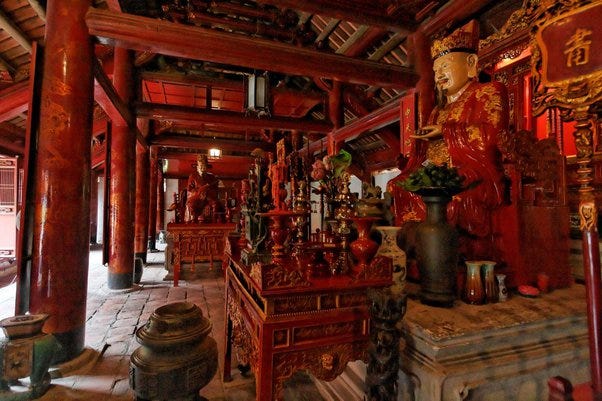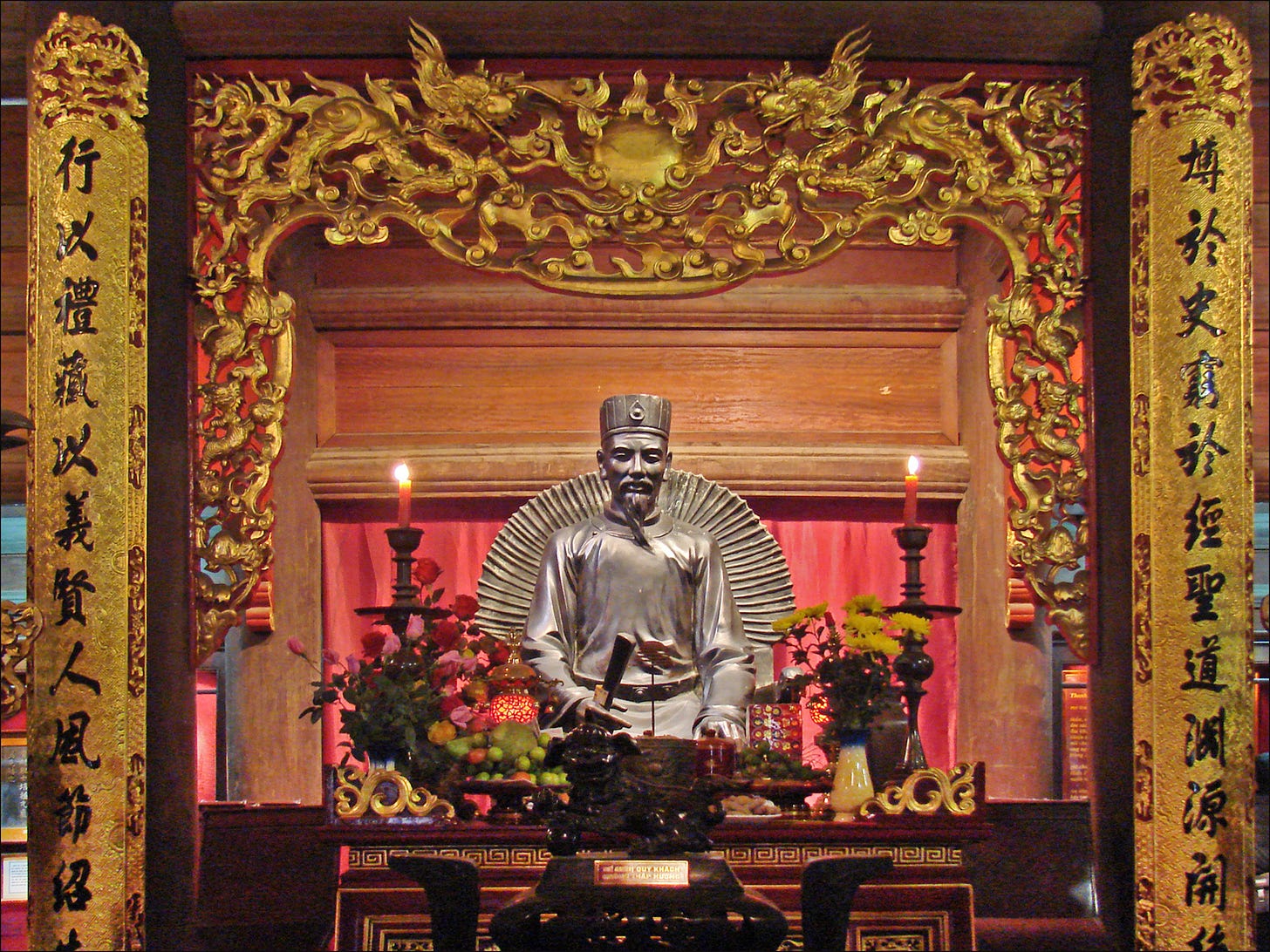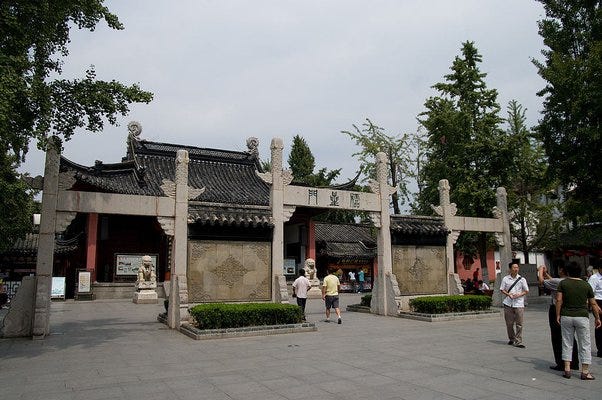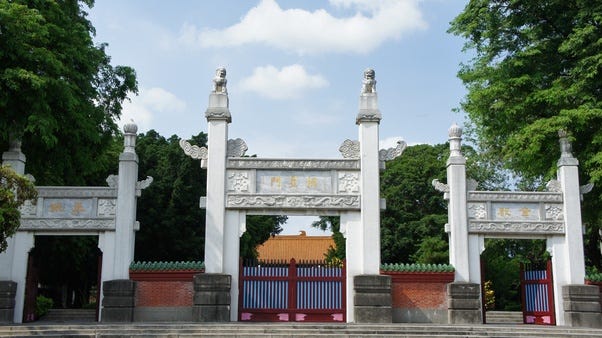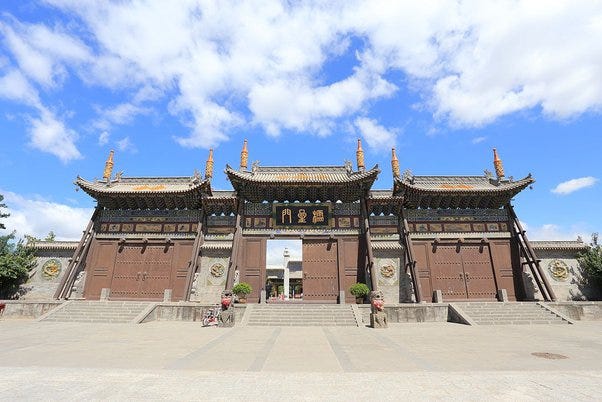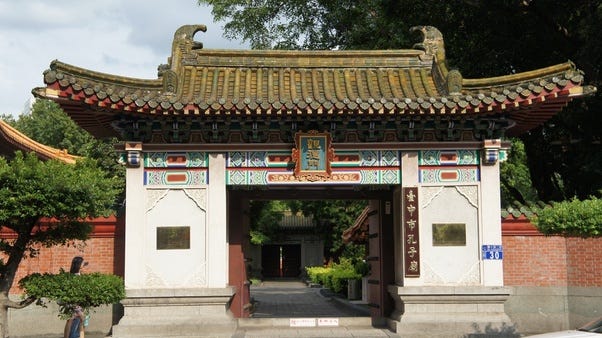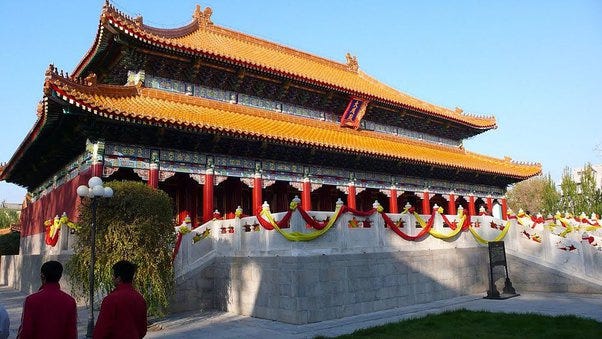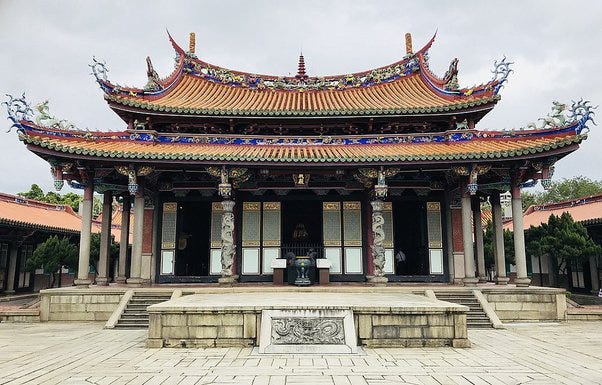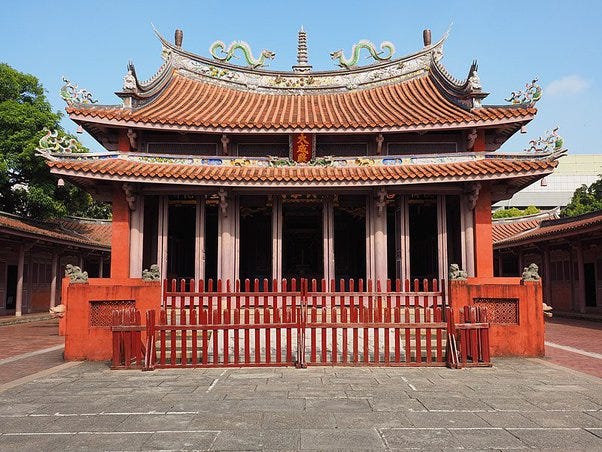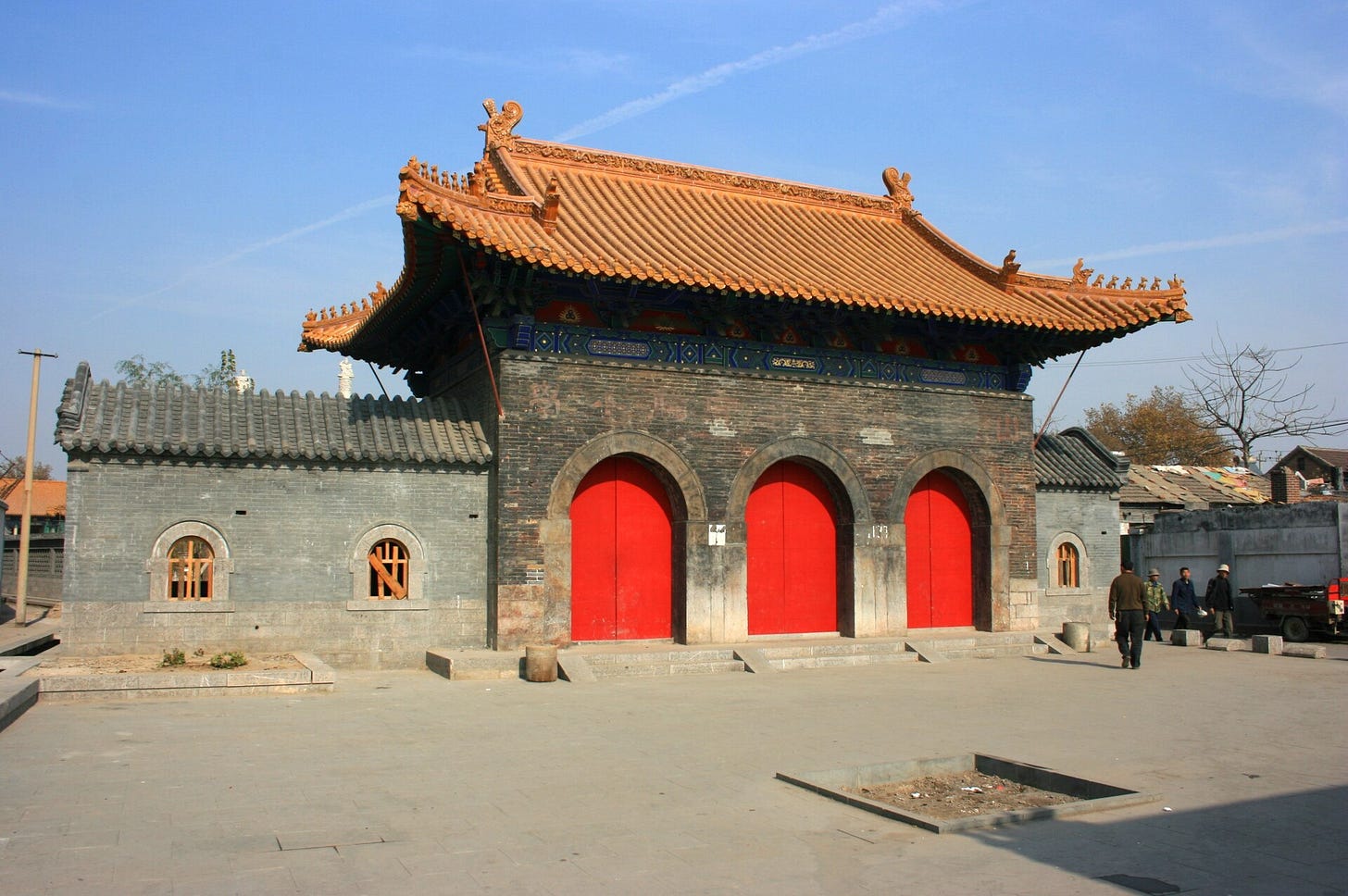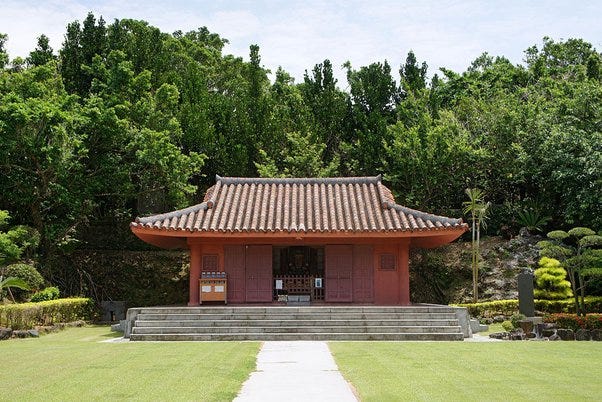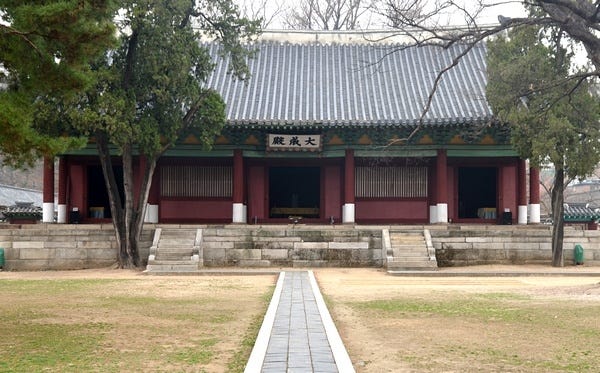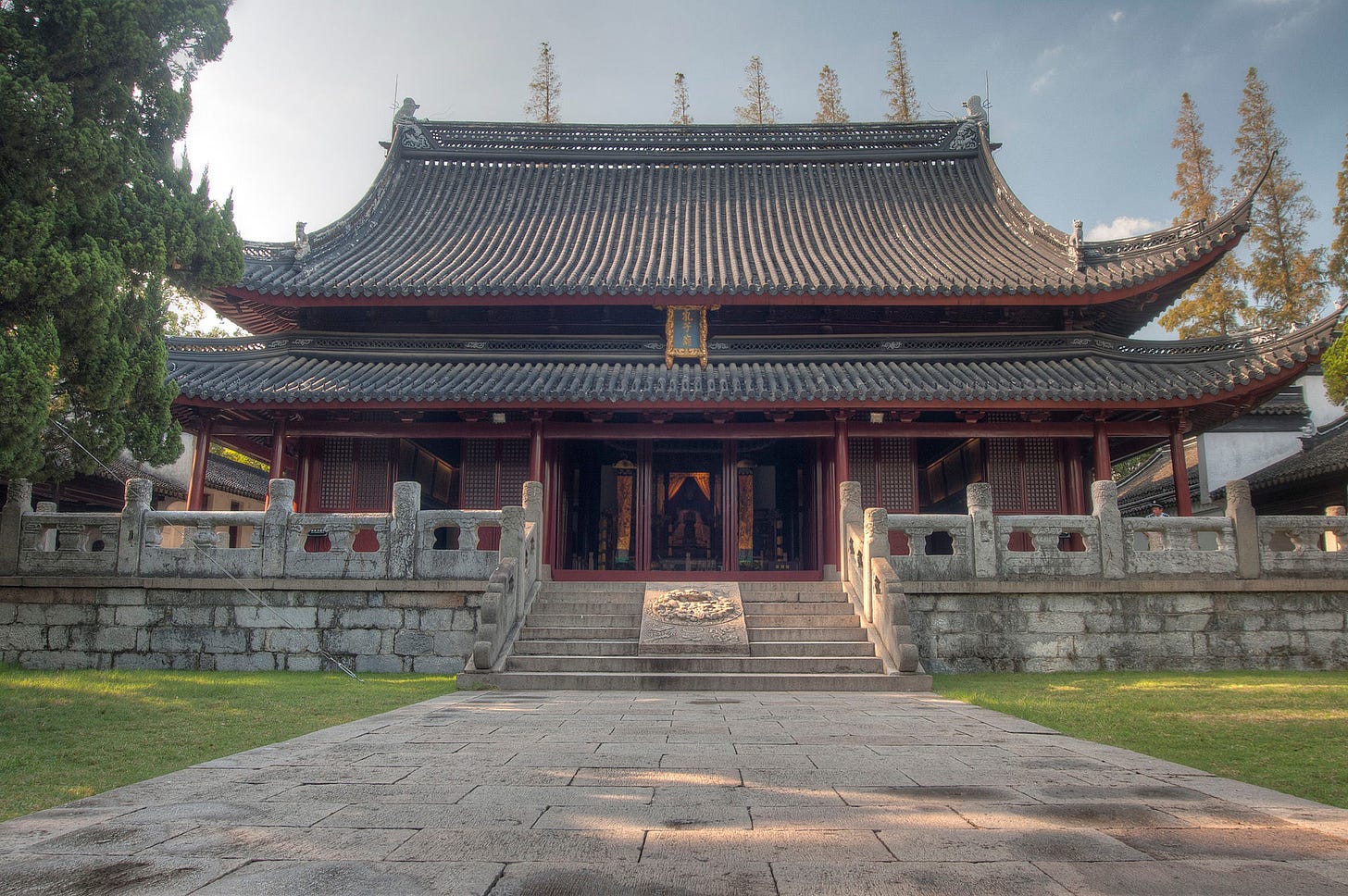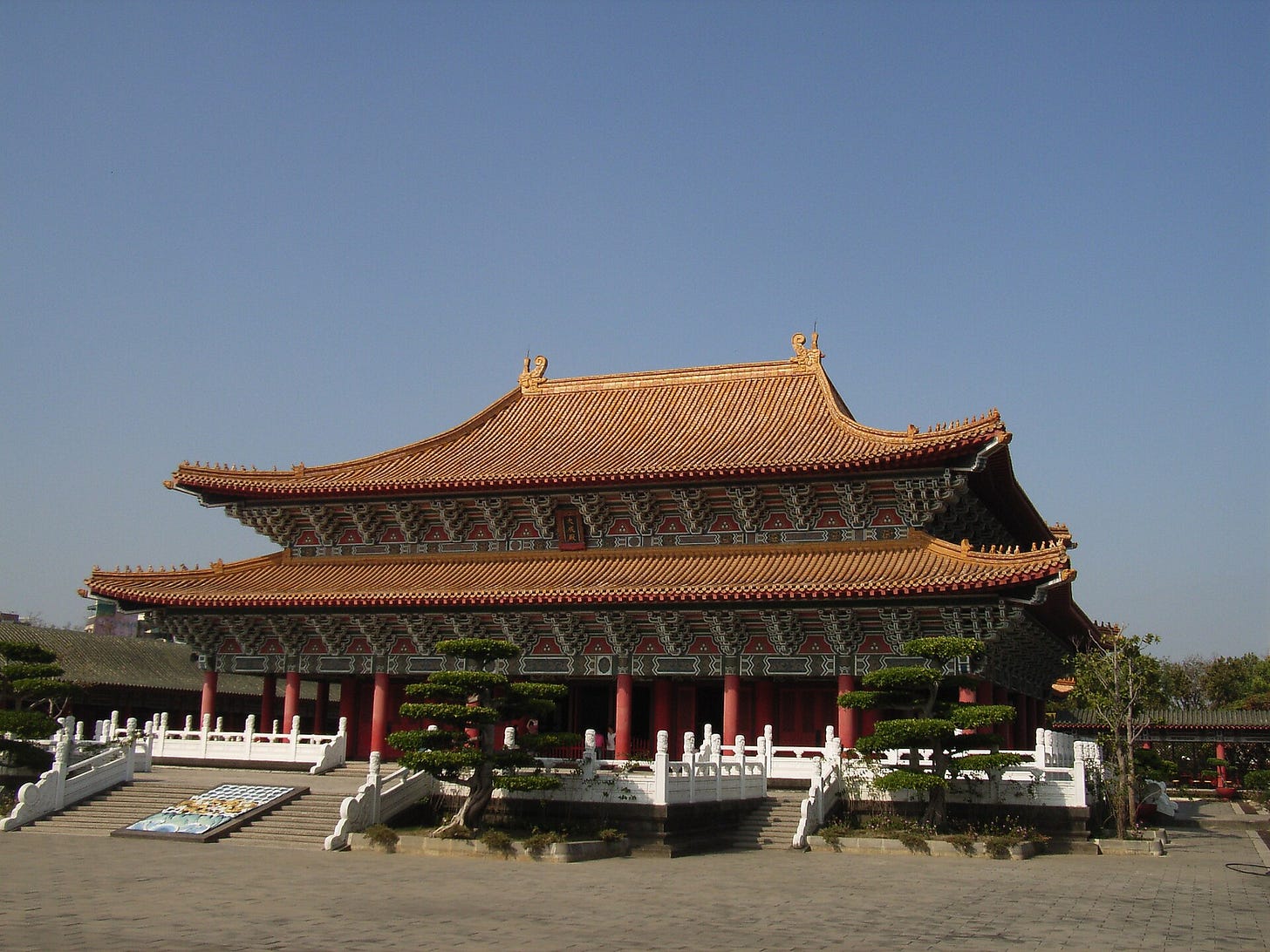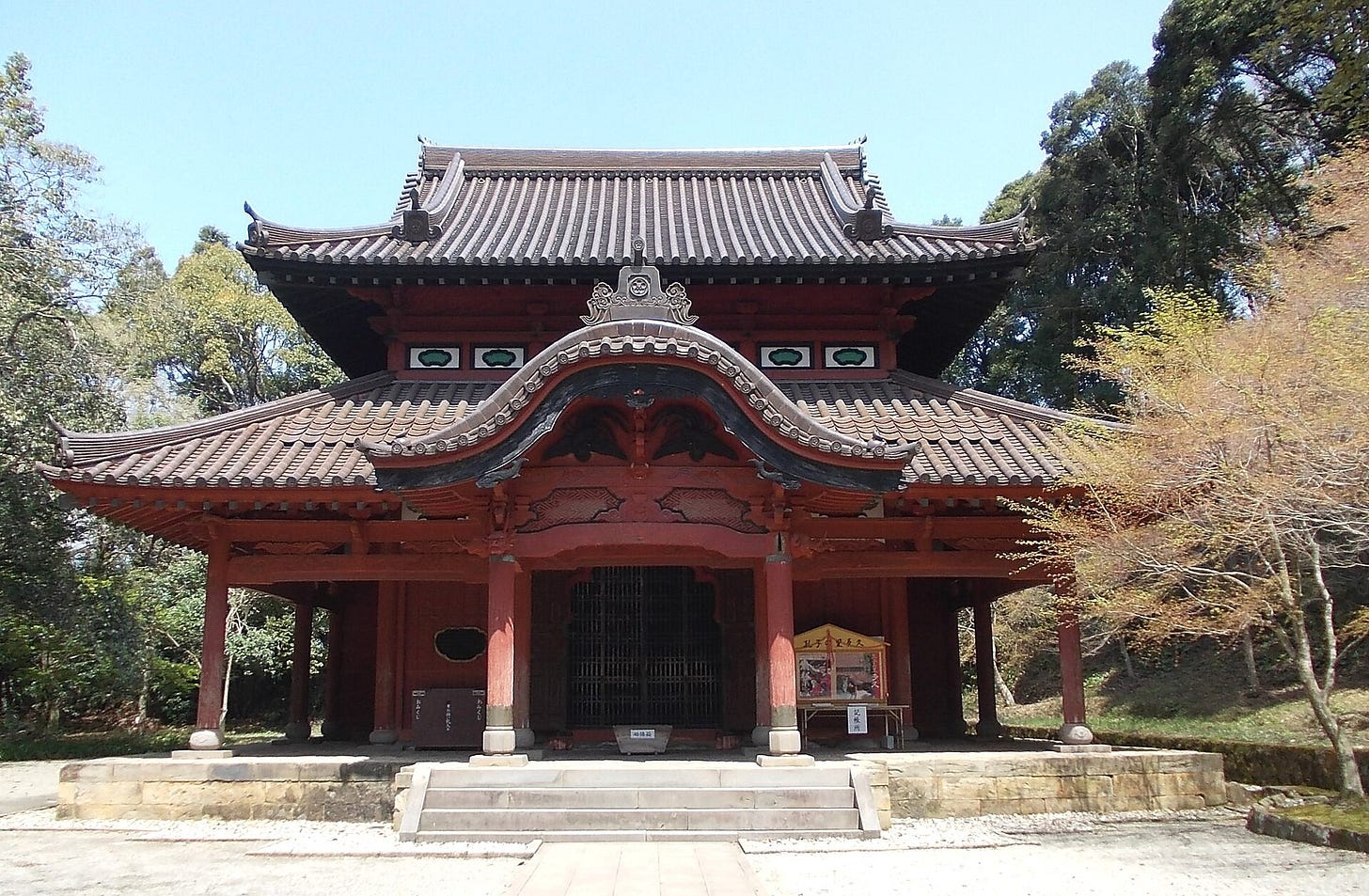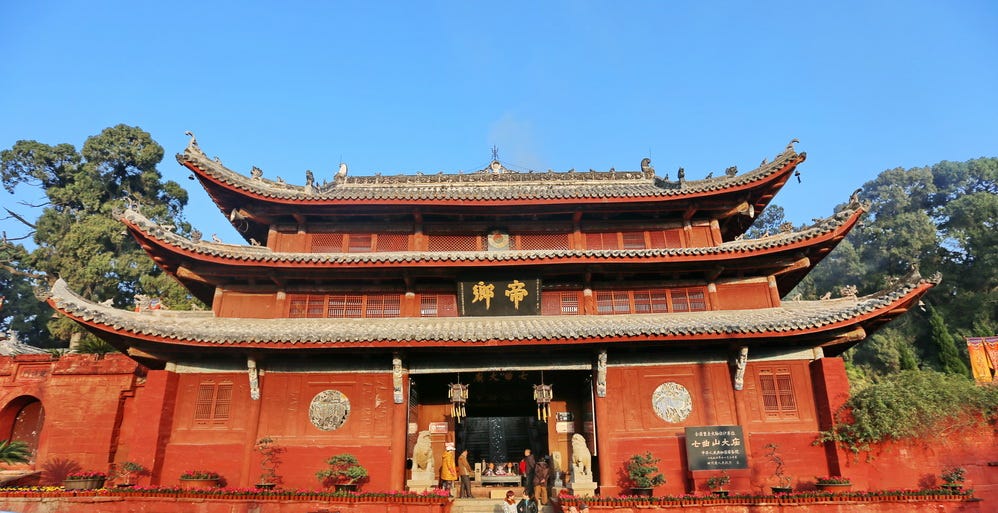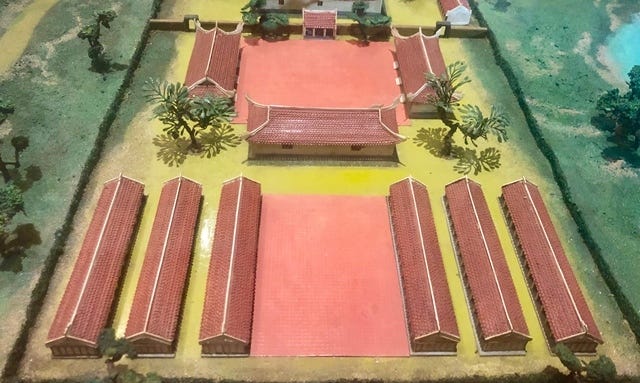Temple Architecture Styles: Zhōngguó and related architecture temples – Wénmiào Complexes
Temples of Literature" (文廟) (Pǔtōnghuà/Guānhuà: Wén Miào; Gwóngdūng wá: Mon Miu; Việt: Văn Miếu; Korean: Munmyo; Bahasa Indonesia: Boen Bio) or "Temples of the Sage of Literature" (Việt: Văn Thánh Miếu) are temples enshrining a Wéndì (civil deity).
Temples by Deity:
Kǒng Miào
Kǒng Miào (Kǒng Fūzǐ Temple Complexes)1 are temple complexes mainly found in eastern and south-eastern Asia dedicated to Zhōngguó philosopher Kǒng Qiū (Latinised name Confucius from Kǒng Fūzǐ (master Kǒng) ; 551 BCE – 479 BCE) and / or his disciples. These temple complexes follow Zhōngguó Temple Architecture proper or its related styles (Việt, Joseon/Hanguk, Nihon or localised varieties of a mix of them).
Rújiā (Confucianism) refers to the philosophical school of thought developed from the teachings of Zhōngguó philosopher Kǒng Qiū and further refined & developed by his disciples & followers. Influenced by Rújiā, the philosophy named Sòng-Míng lǐxué (Neo-Confucianism) originated with philosophers Hán Yù (768 CE – 824 CE) and Lǐ Áo (772 CE – 841 CE) under Táng dynasty, and further developed under subsequent rulers of Zhōngguó, Korea, Nihon and Việt Nam.
These philosophies had far reaching politico-cultural impacts in these regions.
Kǒng Fūzǐ Temple Complexes are known by a variety of names throughout East Asia:
The two greatest temples in Qufu and Beijing are now known in Pǔtōnghuà/Guānhuà as "Temples of Confucius" (Kǒngmiào, 文廟).
In Nihon, they are usually known as "Temples" or "Halls of the Sage" (Japanese: seibyō or seidō, respectively).
Wénchāng Miào
In Southern Zhōngguó, Wénmiào generally honour the deity Wénchāng Wáng2. Wénchāng Wáng temple complexes have their own separate name, as Wénchāng Miào.
General architectural features:
The temple complex usually has 2 or 3 courtyards with the main temple in innermost courtyard. The main temple, situated in innermost courtyard, is called Dàchéngdiàn (Chinese: 大成殿), variously translated as "Hall of Great Achievement", "Hall of Great Completion", or "Hall of Great Perfection".
The temple does not usually have images, but only Shénwèi (Chinese: 神位; Spirit Tablets) of Kǒng Qiū and those of other important Shèngs (simplified Chinese: 圣; traditional Chinese: 聖; sages) and Xiáns (simplified Chinese: 贤; traditional Chinese: 賢; worthies)
Gates are usually termed mén (simplified Chinese: 门; traditional Chinese: 門), with localised names elsewhere.
The front gate of the complex is called Língxīngmén (simplified Chinese: 棂星门; traditional Chinese: 欞星門; Língxīng Gate).
Dàchéngdiàn’s courtyard is entered via Dàchéngmén (simplified Chinese: 大成门; traditional Chinese: 大成門; Dàchéng gate).
Most structures feature sloping roofs, common throughout eastern and south-eastern Asia.
Kǒng Fūzǐ Temple at Qufu in Shandong province, PRC has 9 courtyards, and is the largest example of Kǒng Fūzǐ temple complex.
Development
5rd century BCE – 3rd century BCE
The largest and oldest Kǒng Fūzǐ temple complex is found in Kǒng Qiū's hometown, present-day Qufu in Shandong Province, PRC — it was established in 479 BCE, 1 year after his death, at the order of Duke Ai of State of Lǔ, who commanded that Rújiā-following residence should be used to worship and offer sacrifice to Kǒng Qiū. The temple complex was expanded repeatedly over a period of >2,000 years until it became the huge complex presently standing.
3rd century BCE – 3rd century CE
Hàn Dynasty (202 BCE – 9 CE, 25 CE – 220 CE)
The development of state temples devoted to the cult of Kǒng Qiū was a result of his gradual canonisation. In 195 BCE, Liú Bāng (r. 206–195 BCE), founder of Hàn Dynasty, offered a sacrifice to the spirit of Kǒng Qiūat his tomb in Qufu. Sacrifices to the spirit of Kǒng Qiū and that of Yan Hui, his most prominent disciple, began in Imperial University (Biyong) in ~241 CE.
3rd century CE – 10th century CE
Northern Wèi dynasty (386 CE – 535 CE)
Liú Sòng dynasty (420 CE – 479 CE)
Táng dynasty (618 CE – 690 CE, 705 CE – 907 CE)
Sòng dynasty (960 CE – 1279 CE)
Goryeo kingdom (918 CE – 1392 CE)
Lý dynasty (1009 CE – 1054 CE, 1054 CE – 1225 CE)
Philosophical Developments:
Sòng-Míng lǐxué (Neo-Confucianism) originated with philosophers Hán Yù (768 CE – 824 CE) and Lǐ Áo (772 CE – 841 CE) under Táng dynasty.
Sòng-Míng lǐxué became the orthodox philosophy under Sòng dynasty. During this period, it was developed by philosophers like Zhōu Dūnshí, Zhāng Zài, brothers Chéng Hào & Chéng Yí, Shào Yōng and Zhū Xī.
Temples:
In 454 CE, Liú Sòng dynasty of southern Zhōngguó built a prominent state Kǒng Fūzǐ temple. Suzhou Kǒng Fūzǐ Temple Complex was the first temple school in Zhōngguó, constructed under the Liú Sòng dynasty official & Suzhou Prefect Fan Zhongyan — he combined the State School and the Kǒng Fūzǐ Temple, which began the State education and was imitated by other places,.
In 489 CE, Northern Wèi constructed a Kǒng Fūzǐ temple in the capital, the first outside of Qufu in the north.
In 630 CE, Táng dynasty decreed that schools in all provinces and counties should have a Kǒng Fūzǐ temple, due to which temples spread throughout Zhōngguó. Beginning with Táng Dynasty, Kǒng Fūzǐ temples were built in prefectural and county schools throughout the empire, either to the front of or on one side of the school.
→ Sòng dynasty Fūzǐ Temple Complexes examples:
Suzhou Kǒng Fūzǐ Temple Complex in Suzhou, Jiangsu Province, PRC. It was the first temple school in Zhōngguó and is notable for containing the four greatest steles of Sòng dynasty [Source:File:苏州文庙·棂星门及大殿·航拍.jpg - Wikimedia Commons]
Kǒng Fūzǐ temples in Korea as part of schools were first built during Goryeo period.
The earliest recorded Văn Miếu in Vietnam is Hanoi Văn Miếu established in 1070 CE during Lý dynasty. It was built under emperor Lý Thánh Tông, and hosted Imperial Academy (Quốc Tử Giám, 國子監), Vietnam's first national university, from 1076 CE to 1779 CE. In 1236, the academy was enlarged and named Quốc Tử Viện and later Quốc Học Viện. In the Lê dynasty it was called Thái Học Viện and was developed further. This development included the Minh Luân house, west and east classrooms, a storehouse for wooden printing blocks and two sets of three 25 room dormitories. Khải Thánh shrine was built to honour Kǒng Qiū’s parents.
13th century CE – 20th century CE
Yuán dynasty (1271 CE – 1368 CE)
Míng dynasty (1368 CE – 1644 CE)
Joseon kingdom (1392 CE – 1894 CE, 1894 CE – 1897 CE)
Nihon Edo period : Tokugawa bakufu (1603 CE – 1868 CE)
Qīng dynasty (1636 CE – 1912 CE)
Dōngníng kingdom (1661 CE – 1683 CE)
Philosophical Developments:
Sarim (forest of scholars)3 faction of Sòng-Míng lǐxué emerged under Joseon kingdom. This faction drove the establishment of Seowons, which combined Kǒng Fūzǐ temples and Rújiā academy into one. In 1418 CE King Sejong issued rewards to two scholars for their work in setting up seowons in Gimje and Gwangju.
Under Tokugawa Yoshinao & succeeding shoguns, and under the leadership of Hayashi clan, Nihon Sòng-Míng lǐxué, particularly as developed in the teachings of Zhū Xī became the official orthodoxy and basis of the political philosophy of Tokugawa bakufu. Hayashi school of Rújiā moved at the same time, and after Kansei Edict solidified the position of Sòng-Míng lǐxué as the official philosophy of Nihon, Yushima Seidō Taiseiden school became a state-sponsored academy in 1797 CE, the most important school of this kind in the country for the sons of hatamoto and many of the sons of various daimyo.
Kǒng jiàohuì or Rú jiàohuì (Confucian church) is a Rújiā religious and social institution of the congregational type. It was first proposed by Kang Youwei (1858–1927 CE) near the end of 19th century CE, as a state religion of Qīng dynasty following a European model. "Confucian church" model was later replicated by overseas Chinese communities, who established independent Confucian churches active at the local level, especially in Indonesia and USA.
Temples:
From the time of Joseon kingdom’s ruler Yi Seonggye (r. 1392–1398 CE), Rújiā underpinned the new dynasty and its government. Thus government Rújiā schools (Hanggyo 항교) were built throughout Joseon to educate government officials. These consisted of a building for teaching, together with a building (Daesongjeon 대성전) which housed the memorial tablets of Kǒng Qiū. Although Zhōngguó models were followed, variations in layout and construction were common, such as the building of schools in front of temples. Korea also added its own scholars (the 18 scholars of the East) to the Rújiā pantheon (the 5 sages).
Seowons first appeared in Korea in early Joseon Dynasty, whose establishment were driven mainly by Sarim (forest of scholars) faction of Sòng-Míng lǐxué scholars. The first seowon to receive a royal charter was Sosu Seowon in Punggi, presided over by Toegye, which was given a hanging board by King Myeongjong in 1550 CE. Large numbers of seowons were established by leading seonbi (literati), or by local groups of yangban families. In most cases, seowon served only pupils of the aristocratic yangban class. Some of the Sarim scholars who retired to villages in the wake of literati purges of the 16th century CE used the seowons as their political bases. They were modeled after early private Zhōngguó academies of classical learning Shūyuàn (which originated in 8th century CE under Tang dynasty, and were later dismantled under the Yuan dynasty to become preparatory schools for the imperial examinations under government control). Most seowon were closed by an edict of the regent Daewon-gun in the turbulent final years of the 19th century CE. He banned the unauthorized construction of seowons in 1864 CE, and removed their tax exemption in 1868 CE; finally, in 1871 CE, he ordered all but a handful closed. The provincial yangban were outraged by these measures, and this is among the reasons that Daewon-gun was driven from power in 1873 CE; however, the seowon remained closed
→ Joseon kingdom founded Kǒng Fūzǐ temple complexes examples:
Daeseongjeon of Seonggyungwan Munmyo Complex, Sungkyunkwan University, Seoul, RoK. The buildings of Munmyo were first constructed in 1398 CE, but they were destroyed in a fire in 1400 CE, and rebuilt in 1407 CE. The temple was again destroyed during Nihon invasions of Korea in 1592–1598 CE. The Daeseongjeon was rebuilt in 1601 CE and the Myeongnyundang in 1606 CE with funds raised by students of Sungkyunkwan. Repairs to the complex were conducted in 1869 CE. [Source: File:Sungkyunkwan Daeseongjeon.jpg - Wikimedia Commons]
Běijīng Kǒngmiào (Beijing Temple of Confucius), the second largest Kǒng Fūzǐ temple complex was first built in 1302 CE under emperor Temür of Yuán dynasty. Until 1911 Xinhai Revolution, imperial officials of Yuán, Míng and Qīng dynasties hosted ceremonies to pay their formal respects to Kǒng Qiū in the temple.
→ Yuán dynasty founded Kǒng Fūzǐ temple complexes examples:
Shànghǎi Wénmiào was first founded during Yuán Dynasty, when Shanghai, once a small fishing village, was elevated to the status of a county seat. It was also the most prestigious learning institution of the county, as in ancient times a Kǒng Fūzǐ Temple was typically a combination of temple and school. In the following centuries, it was rebuilt several times. From 1851 CE to 1855 CE, the temple was occupied by Small Swords Society and became their headquarters. The temple was almost completely destroyed during the battle when government troops retook control of it. The government eventually decided to rebuild the temple at the present site. The temple was badly damaged during the Cultural Revolution, but in 1995 CE it was designated for renovation by the local government. [Source: File:Confucius Temple of Shanghai2.jpg - Wikimedia Commons]
→ Qīng dynasty founded Kǒng Fūzǐ temple complexes examples:
Táiběi Kǒngzǐ Miào was built in 1879 CE under Qīng dynasty, after Taipeh Prefecture was established in 1875 CE. [Source: File:Taipei Confucius Temple 1.jpg - Wikimedia Commons]
In 1632 CE, Tokugawa Yoshinao, the 9th son of Tokugawa Ieyasu and daimyō of Owari Domain was granted permission to build an academy in Edo for the study and propagation of Rújiā. The first structure was Sensei-den (先聖殿), constructed by Sòng-Míng lǐxué scholar Hayashi Razan (1583 CE – 1657 CE) in his grounds at Shinobu-ga-oka (now in Ueno Park). The fifth shogun, Tokugawa Tsunayoshi, moved the building to its present site in 1691 CE, where it became the Taiseiden (大成殿) of Yushima Seidō.
→ Tokugawa bakufu founded Kǒng Fūzǐ temple complexes examples:
Taiseiden of Yushima Seidō in Yushima, Bunkyō, Tokyo, Japan (Established 1691 CE at present location) [Source: File:Yushima Seido 002.jpg - Wikimedia Commons]
The first Kǒng Fūzǐ temple in Taiwan to be constructed was Táinán Kǒngzǐ Miào, which was built under Han ethnic Dōngníng kingdom in 1665 CE in Tainan.
Starting in 18th century CE, some Kǒng Fūzǐ temple complexes were built in Europe and Americas.
20th century CE – present
Republic of China (1912 CE – 1949 CE)
Japan (1947 CE – present)
Republic of Korea (1948 CE – present)
Democratic People's Republic of Korea (1948 CE – present)
People’s Republic of China (1949 CE – present)
Socialist Republic of Vietnam (1976 CE – present)
By 20th century CE, there were a total of 162 figures worshipped in Kǒng Fūzǐ temple complexes.
The surviving Edo period structures of Nihon’s Yushima Seidō were all destroyed in 1923 Great Kanto Earthquake. The current Yushima Seidō building was designed by Itō Chūta and was completed in 1935.
In 1946, the 5th courtyard of Hanoi Văn Miếu was destroyed during the First Indochina War. In 2000, it was reconstructed on grounds of the original Imperial Academy. It honours the talents, the national traditions and the culture and education of Vietnam. The design of the new fifth courtyard were based on the traditional architecture in harmony with the surrounding sights of the temple. Several buildings were constructed including the front building, the rear building, the left and right buildings, a bell house and a drum house.
The bill allowing for the building of the very first Kǒng Fūzǐ temple in Hong Kong, proposed by the Confucian Academy, passed in September 2013.
Structural Details
Worship and Rituals
Yǎyuè (Chinese: 雅樂 ; elegant music)
Yǎyuè (Chinese: 雅樂 ; elegant music)
Yǎyuè4 was a form of classical music and dance performed at the royal court and temples in ancient Zhōngguó. The basic conventions of yǎyuè were established in the Western Zhōu. Together with law and rites, it formed the formal representation of aristocratic political power.
During Táng dynasty components of popular music were added to yǎyuè. However, the dominant form of music in Suí and Táng court was the entertainment music for banquets called yanyue (燕樂), and the term yayue became reserved for the music of Rújiā rituals used in temples of the Imperial Family and the nobility as well as in Kǒngmiàos.
During Sòng dynasty, with Sòng-Míng lǐxué becoming the new orthodoxy, yǎyuè was again in ascendancy with major development, and a yayue orchestra in this era consisted of >200 instrumentalists with many instruments added to the orchestra. Some forms of yǎyuè survived for imperial ceremonies and rituals until the fall of Qing dynasty when the imperial period of Zhōngguó came to an end. Yǎyuè however was still performed as part of a Confucian ritual in Zhōngguó until the Communist takeover in 1949 CE when it completely disappeared.
There has been a revival in yǎyuè in Confucian ritual in Taiwan since the late 1960s CE, and in mainland China since the 1990s CE. A major research and modern reconstruction of yayue of the imperial court was initiated in Taiwan in the 1990s CE, and in mainland Zhōngguó a performance of yayue music in 2009 CE by Nanhua University's yayue music ensemble in Beijing also spurred interest in this form of music. There are however questions over the authenticity of these revived and recreated yǎyuè music and dances, especially the use of modern forms of instruments and various substitutions rather than the more ancient and original forms, nonetheless some argued that such music and dances have always changed over time through succeeding dynasties, and that any changes introduced in the modern era should be seen in this light.
Aak (아악, 雅樂)
In 1116 CE, a gift of 428 yǎyuè instruments as well as 572 costumes and dance objects was given to Korea by Emperor Huizong of Sòng upon request by Emperor Yejong of Goryeo. As a result, elements of Sòng dynasty yǎyuè music, called Aak5 in Korean, such as melodies are still preserved in Korea.
→ [Sources: https://en.wikipedia.org/wiki/Yayue and https://en.wikipedia.org/wiki/Aak]

Altars
Altars are present in the complex dedicated to Kǒng Qiū and his disciples. There can be altars for other figures as well including those part of Rújiā pantheon, and people important in regards to the temple complex’s location.
→ Altars to Kǒng Qiū and his disciples:
Altar to Kǒng Qiū and his disciples in Hanoi Văn Miếu complex in Hanoi, Vietnam. [Source: Temple of Literature, Hanoi - Wikipedia]
→ Altars to Wénchāng Wáng:
Altar to Wénchāng Wáng and Kuí Xīng in a temple of Quanzhou, Fujian, PRC [Source: https://en.wikipedia.org/wiki/Wenchang_Wang]
→ Altars to imperial academy teachers:
Altar to Chu Văn An, a teacher at the imperial academy, in Hanoi Văn Miếu complex in Hanoi, Vietnam. [Source: Temple of Literature, Hanoi - Wikipedia]
Imagery and Ceremonies
Kǒng Qiū and his disciples
In the early years of the Qufu temple complex, it appears that the spirits of Kǒng Qiū and his disciples were represented with wall paintings and clay or wooden statues. Official temples also contained images of Kǒng Qiū himself. However, there was opposition to this practice, which was seen as imitative of Buddhist temples. It was also argued that the point of the imperial temples was to honour Kǒng Fūzǐ's teachings, not the man himself.
The lack of unity in likenesses in statues of Kǒng Qiū led Emperor Taizu of Míng dynasty to decree that all new Kǒng Fūzǐ temples should contain only spirit tablets and no images. In 1530 CE, it was decided that all existing images of Kǒng Qiū should be replaced with spirit tablets in imperial temples in the capital and other bureaucratic locations; nevertheless many modern Kǒng Fūzǐ temples do feature statues. Statues also remained in temples operated by Kǒng Fūzǐ's family descendants, such as that in Qufu.
Originally Kǒng Qiū was honoured with a Six-Row Dance, as performed for the lesser aristocracy, but in 1477 CE Kǒng Qiū was allowed the imperial honour of Eight-Row Dance (bāyìwǔ; 八佾舞) since he posthumously received the title of king.
Wénchāng Wáng
Wénchāng Wáng was officially apotheosized by Yen Yu of Yuán dynasty in 1314 CE as the Supporter of Yuán Dynasty.
He may be accompanied by Kuí Xīng (Chief Star), a being viewed as a saint of human fortune, particularly with regard to imperial examinations.
Deity groupings
Sì Pèi (Four Sages)
Sì Pèi (Four Sages) are 4 Rújiā philosophers whose spirit tablets are traditionally placed, 2 each, to east and west of Kǒng Qiū’s spirit tablet.
The Four Sages are:
Yán Huí (521 BCE – 481 BCE), Kǒng Qiū’s favourite disciple, one of the main characters in Lúnyǔ (Viet: Luận ngữ, Korean: Noneo, Nihon: Rongo; Analects)
Zēng Shēn (505 BCE – 435 BCE), another disciple of Kǒng Qiū and author of Dàxué (Viet: Đại Học, Korean: Daehak, Nihon: Daigaku; Great Learning)
Kǒng Jí (481 BCE – 402 BCE), Kǒng Qiū's grandson, student of Zēng Shēn, and author of Zhōngyōng (Viet: Trung Dung, Korean: Jungyong, Nihon: Chūyō; Doctrine of the Mean)
Mèng Kē (372 BCE – 289 BCE), student of Kǒng Jí and author of Mèngzǐ (Viet: Mạnh Tử, Korean: Maengja; [Writings of] Master Mèng).
Within a traditional Kǒngmiào, Yán Huí's tablet is placed first to the east of Kǒng Qiū.
Shí'èr Zhé (Twelve Philosophers)
They are traditionally accounted a kind of sainthood and their spirit tablets are prominently placed in Kǒngmiàos, 6 on east and 6 on west side of Dàchéngdiàn.
Shí'èr Zhé include 11 disciples of Kǒng Qiū: Mǐn Sǔn, Rǎn Yōng, Duānmù Cì, Zhòng Yóu, Bǔ Shāng, Yǒu Ruò, Zǎi Yǔ, Rǎn Gēng, Rǎn Qiú, Yán Yǎn, and Zhuānsūn Shī, and Sòng-Míng lǐxué scholar Zhū Xī.
Gateways
Zhōngguó: Mén
Korea: Mun
Việt: Tam môn
Gateways can range between relatively simple structures to highly elaborate ones. Usually, Língxīngmén is a compound gate formed by a large gate flanked by 2 smaller ones, while other gates may or may not follow this pattern.
Gateways by type
Páifāng a.k.a. Páilóu
Páifāng is a traditional style of Zhōngguó architectural arch or gateway structure. Páifāng can be found in many Zhōngguó temple complexes, including Kǒng Fūzǐ temple complexes.
A Páifāng can have 1, 3 or 5 entrances. It usually doesnt have any useful physical space except maybe for keeping some icons / statues.
→ Kǒng Fūzǐ temple complexes Páifāng examples:
Páifāng of Táizhōng Shì Kǒngmiào, North district, Taichung, Taiwan [Source: File:Taichung Confucius Temple by Memorial arch.JPG - Wikimedia Commons]
Gateways by function & name
Língxīngmén
→ Língxīng gates examples:
Páifāng type Língxīng gate of Nanjing Fuzimiao in Nanjing City, Jiangsu Province, PRC — simple triple gate structure with each gate being simple architraved structure [Source: Nanjing Fuzimiao - Wikipedia]
Páifāng type Língxīng gate of Temple of Yan Hui in Qufu, Shandong Province, PRC [Source: Temple of Yan Hui - Wikipedia]
Páifāng type Língxīng gate of Táizhōng Shì Kǒngmiào, North district, Taichung, Taiwan, RoC [Source: File:Taichung Confucius Temple by Lingxing Gate.JPG - Wikimedia Commons]
Língxīng gate of Confucian temple in Datong, Shanxi, PRC — an elaborate triple gateway with each gate having own sloped roofs and spires on each side [Source: Temple of Confucius - Wikipedia]
Língxīng gate of Temple of Literature complex in Hanoi, Vietnam — The bell located above the main gate was used to signify that an important person was coming through and was added to the Văn Miếu in 19th century CE. The bell was made out of Bronze and could only be touched by monks. [Source: File:Temple of Literature - main gate.jpg]
Língxīng gate of Shiseibyō in Wakasa district of Naha, Okinawa, Japan [Source: Shiseibyō - Wikipedia]
Other gates
→ Other gates examples:
Gate in 2nd courtyard of Temple of Literature complex in Hanoi, Vietnam — a single gate with an elaborate roof over it. [Source: Temple of Literature, Hanoi - Wikipedia]
Guande Gate of Táizhōng Shì Kǒngmiào, North district, Taichung, Taiwan [Source: File:Taichung Confucius Temple by The Perceiving Virtue Gate.JPG - Wikimedia Commons]
Halls
Hall of Great Achievement (大成殿 ; Chinese: Dàchéngdiàn ; Korean : Daeseongjeon ; Japanese: Taiseiden)
The variations in Halls of Great Achievement are mainly seen with respect to size, decorations and roofing styles. Usually, the halls are 2-storeyed, and are constructed on raised platform. The hall’s entrance is reached by a series of stairs.
Dàchéngdiàn may be reached by gates named Dàchéng gates.
Dàchéngdiàn (Zhōngguó)
Ta Cheng hall
→ Dàchéngdiàn (Zhōngguó) examples:
Inside Dàchéngdiàn of Kǒng Fūzǐ Temple Complex in Ningbo, Zhejiang, PRC [Source: Temple of Confucius - Wikipedia]
Dàchéngdiàn of Kǒng Fūzǐ Temple Complex in Harbin, Heilongjiang province, PRC [Source: Temple of Confucius - Wikipedia]
Dàchéngdiàn of Taipei Kǒng Fūzǐ Temple Complex in Datong district, Taipei, Taiwan — features profuse decorations and spires. [Source: Taipei Confucius Temple - Wikipedia]
Ta Cheng hall, central hall of Kǒng Fūzǐ Temple Complex, Tainan, Taiwan — the the upper storey has dragon statues on it and a small tower in middle of them [Source: Taiwan Confucian Temple - Wikipedia]
→ Dàchéng gates examples:
Triple arched Dàchéng gate of Fuxue Wénmiào in Jinan, Lixia District, Jinan Prefecture, Shandong Province, PRC [Source: https://en.wikipedia.org/wiki/File:Confucian_temple_jinan_2008_11.jpg]
Taiseiden (Nihon)
→ Taiseiden (Nihon) examples:
Taiseiden of Shiseibyō in Wakasa district of Naha, Okinawa, Japan — a relatively simple, single storey structure with roofing style commonly found in Japan [Source: Shiseibyō - Wikipedia]
Taiseiden of Yushima Seidō in Yushima, Bunkyō, Tokyo, Japan (Established 1691 CE at present location) [Source: File:Yushima Seido 002.jpg - Wikimedia Commons]
Daeseongjeon (Korea)
→ Daeseongjeon (Korea) examples:
Daeseongjeon of Seonggyungwan Munmyo Complex, Sungkyunkwan University, Seoul, RoK [Source: File:Sungkyunkwan Daeseongjeon.jpg - Wikimedia Commons]
Temple Complexes
Temple complexes by enshrined deities
Kǒng Fūzǐ Temple Complexes
→ Kǒng Fūzǐ Temple Complexes examples:
Kǒng Fūzǐ Temple Complex in Jiading of Shanghai, PRC [Source: https://en.wikipedia.org/wiki/Temple_of_Confucius]
Gāoxióng Kǒngzǐ Miào in Kaohsiung, Taiwan. [Source: https://en.wikipedia.org/wiki/File:Zuoying_Confucian_Temple.jpg]
Taku Seibyō in Taku, Saga, Japan — the entrance features Karahafu type curved roof unique to Nihon architecture [Source: https://en.wikipedia.org/wiki/File:Taku_Seibyo_02.jpg]
Văn Miếu Trấn Biên in Bửu Long, Biên Hòa, Đồng Nai province, Vietnam [Source: https://en.wikipedia.org/wiki/File:Nh%C3%A0_th%E1%BB%9D_ch%C3%ADnh_V%C4%83n_mi%E1%BA%BFu_Tr%E1%BA%A5n_Bi%C3%AAn.jpg]
Yán Huí Temple Complexes
Yán Huí (c. 521 BCE – 481 BCE) was the favourite disciple of Kǒng Qiū. He was conferred the title Fùshèng (2nd sage {1st sage being Kǒng Qiū}) in 1530 CE under the reign of 12th Míng emperor Zhū Hòucōng. Therefore, halls dedicated to him may be named Fùshèng halls.
→ Yán Huí Temple Complexes examples:
Fùshèng Hall of Yán miào in Qufu, Jining, Shandong, PRC [Source: https://en.wikipedia.org/wiki/Temple_of_Yan_Hui]
Wénchāng Wáng Temple Complexes
→ Wénchāng Wáng Temple Complexes examples:
Wénchāng Wáng Temple Complex in Zitong, Sichuan province, PRC [Source: https://en.wikipedia.org/wiki/Wenchang_Wang]
Běitún Wénchāng Miào in Renmei Village, Beitun District, Taichung, Taiwan [Source: https://en.wikipedia.org/wiki/File:Beitun_Wenchang_Temple.JPG]
Layout
The temple complexes can range from small relatively simple structures to highly elaborate and large structures.
→ Rújiā temple complexes layouts examples:
Layout of Kǒng miào complex in Qufu, Shandong Province, PRC [Source: http://a.org/wiki/Temple_of_Confucius,_Qufu#/media/File:Confuciustemplequfu.png]
Layout of Fuxue Wénmiào in Jinan, Lixia District, Jinan Prefecture, Shandong Province, PRC [Source: https://en.wikipedia.org/wiki/File:%E6%B5%8E%E5%8D%97%E6%96%87%E5%BA%99_map.jpg]
Model of Hanoi Văn Miếu as per its layout during Lê dynasty period [Source: https://en.wikipedia.org/wiki/File:Old_college.jpg]
https://en.wikipedia.org/wiki/Temple_of_Confucius
https://en.wikipedia.org/wiki/Wenchang_Wang
https://en.wikipedia.org/wiki/Sarim
https://en.wikipedia.org/wiki/Yayue
https://en.wikipedia.org/wiki/Aak








